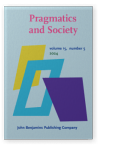Vol. 15:5 (2024) ► pp.755–778
Politely warning?
A usage-based analysis of directives in Japanese disaster warnings on Twitter
Taking a usage-based approach, this study examines the social meaning of Japanese honorifics when they are used in call-to-action statements in official disaster warnings on Twitter. This study finds two honorific request constructions, Verb-te kudasai and o-Verb kudasai, to be dominant directives used in the data collected for this study. Discourse analysis of the texts found the two honorific request constructions signaling different levels of severity of the impending threats in accordance with the different degrees of freedom of actions given to the warning recipients upon complying with the recommended actions. The findings also suggest the use of honorifics helps maintain the warning sender’s institutional identity as they communicate safety information to the public on behalf of the meteorological agency. This paper extends the discussion of the multifunctionality of honorifics by highlighting the use of them in digitally mediated institutional discourse contexts.
Article outline
- 1.Introduction
- 2.Literature Review
- 2.1Functions of Honorifics
- 2.2Verb-te kudasai construction
- 2.3 o-Verb kudasai construction
- 2.4Honorifics in Japanese public discourse
- 3.Data and Methods
- 4.Results
- 4.1Warnings with Verb-te kudasai construction
- 4.2Warnings with o-Verb kudasai construction
- 5.Discussion
- 6.Conclusion
- Acknowledgements
- Notes
-
References
